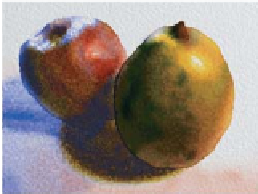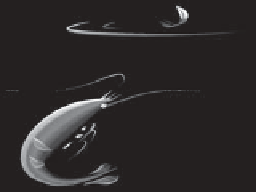Graphics Reference
In-Depth Information
stick figure, or just a circle on a page, our minds can rapidly interpret this as the
representation of a 3D shape—a human form, or a sphere. In fact, the tendency
to see shape is almost overwhelming. Although when we look at a drawing we
see pencil strokes on a piece of paper, when asked about it we always describe
the thing depicted rather than saying, “I see a piece of paper with pencil strokes
on it.” This interpretation of strokes as representing shapes appears to be closely
tied to our perceptual processes, in which edge detection is a first step. The strokes
seem to manage to convey “edge-ness” directly, although each stroke, in principle,
ought to convey
two
edges, one on either side of the stroke, as light transitions to
dark and again as dark transitions to light.
Marks and strokes in expressive rendering systems are created by several
approaches.
First there's the scanning/photography approach: An individual paint stroke
on a canvas of contrasting color is photographed, and using the contrasting color,
an
Figure 34.6: A small offset from
the central red curve results in the
smooth green outer curve; at the
focal distance in the other direc-
tion, where nearby normals meet,
we get a degeneracy—the sharp
ends of the blue inner curve.
-value for each pixel near the boundary of the stroke is estimated. This is done
for many example strokes, and then when it comes time to place strokes on the
virtual canvas, the scanned strokes are recolored as needed and composited onto
the canvas. The same approach has been used with charcoal and pencil marks,
and can clearly be used with mosaic tiles, pastels, etc., as well. This approach
may seem to be the simplest, but the actual scanning and processing of oil-paint
strokes, for instance, turns out to be quite difficult.
α
Second, there's imitation of artistic technique, such as the pen-and-ink strokes
used by Salisbury et al. [SWHS97], in which the core system determined the need
for a curved stroke following some general path, and then the stroke-generating
system created a spline path that approximated the general path, but had small per-
turbations in the normal direction to emulate the wiggliness of hand-drawn lines
(the degree of wiggle was user-controllable), and which tapered to a point at each
end, with the length of the taper also being user-controllable. Similar approaches
were used by Northrup et al. [NM00] for a watercolor-like rendering. The idea of
expanding or varying a stroke in the normal direction is a good one, but problems
arise at
focal points,
where nearby normal lines cross (see Figure 34.6). These
problems can be mostly addressed by adjusting the notion of “normal lines” to
allow some bending and compression; Hsu et al. took this approach in their work
on skeletal strokes [HLW93].
Figure 34.7: A watercolor
produced with Curtis's system.
(Courtesy of Cassidy Curtis.
©1997 ACM, Inc. Reprinted by
permission.)
Finally, there's the physical simulation of media and tools. Physical simu-
lation, of course, depends on a model of the thing being simulated, and such
models may range from very accurate to somewhat informal. Curtis [CAS
+
97]
used fluid simulation to model the flow of water and pigment in watercolors (see
Figure 34.7); Strassmann [Str86] used a minimal physical model of a brush (a
linear array of bristles of slightly varying lengths, each of which responds to both
paper texture and pressure applied by the user), paper, and ink to allow a user to
create sumi-e paintings like the one shown in Figure 34.8; Baxter and Lin [BL04]
extended this model to handle far greater complexity, including interbristle coher-
ence and physically based deformation of the brush and bristles.
Figure
34.8:
A
sumi-e
paint-
ing
created
with
Strassmann's
system.
(Courtesy
of
Steve
Strassmann.
©1986
ACM,
Inc.
Reprinted by permission.)
As we discussed in Chapter 5, the human visual system is sensitive to certain
characteristics of arriving light, and not so sensitive to others. Those to which it's
most sensitive are good candidates for inclusion in an expressive rendering.








